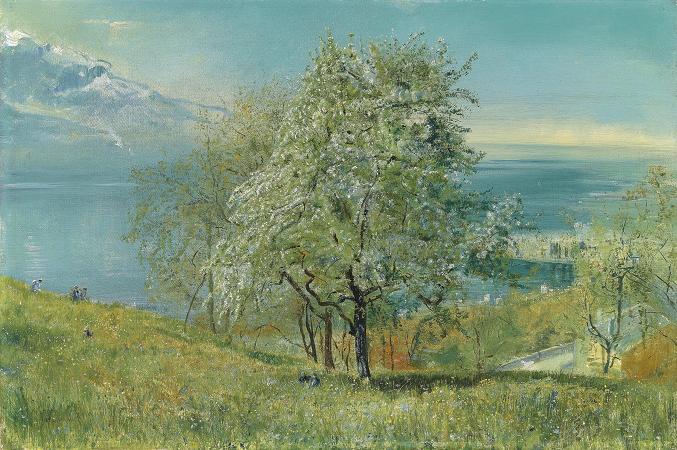
John William Inchbold. John William Inchbold was an English painter who was born in Leeds, Yorkshire.
His style was influenced by the Pre-Raphaelite Brotherhood. He was the son of a Yorkshire newspaper owner, Thomas Inchbold.
Inchbold was born 29 April 1830 at Leeds, Yorkshire, where his father, Thomas Inchbold, was the proprietor and editor of the Leeds Intelligencer. Having shown an early talent for drawing he moved to London and became a draughtsman in the lithographic works of Day and Haghe.
Inchbold became a pupil of Louis Haghe, the water-colour painter, and was a student at the Royal Academy in 1847. He exhibited at the Society of British Artists in 1849, at the Academy from 1851.
At first he worked in watercolour in a free style, but his first exhibited oil painting, shown at the Academy in 1852 showed the influence of the Pre-Raphaelite movement, and in 1855 he gained the enthusiastic praise of John Ruskin for The Moorland, which he painted to illustrate a passage from Tennyson's Locksley Hall. His painting, White Doe of Rylstone was purchased by Ruskin. Inchbold spent much of the later part of his life abroad, mainly in Switzerland, where he had spent some time with Ruskin in the mid-1850s. His best-known works are probably The Jungfrau, On the Lake of Thun, Tintagel, Gordale Scar and Drifting; the last named was once in the possession of Coventry Patmore. Tennyson, Browning, Lord Houghton,
His style was influenced by the Pre-Raphaelite Brotherhood. He was the son of a Yorkshire newspaper owner, Thomas Inchbold.
Inchbold was born 29 April 1830 at Leeds, Yorkshire, where his father, Thomas Inchbold, was the proprietor and editor of the Leeds Intelligencer. Having shown an early talent for drawing he moved to London and became a draughtsman in the lithographic works of Day and Haghe.
Inchbold became a pupil of Louis Haghe, the water-colour painter, and was a student at the Royal Academy in 1847. He exhibited at the Society of British Artists in 1849, at the Academy from 1851.
At first he worked in watercolour in a free style, but his first exhibited oil painting, shown at the Academy in 1852 showed the influence of the Pre-Raphaelite movement, and in 1855 he gained the enthusiastic praise of John Ruskin for The Moorland, which he painted to illustrate a passage from Tennyson's Locksley Hall. His painting, White Doe of Rylstone was purchased by Ruskin. Inchbold spent much of the later part of his life abroad, mainly in Switzerland, where he had spent some time with Ruskin in the mid-1850s. His best-known works are probably The Jungfrau, On the Lake of Thun, Tintagel, Gordale Scar and Drifting; the last named was once in the possession of Coventry Patmore. Tennyson, Browning, Lord Houghton,
Wikipedia ...